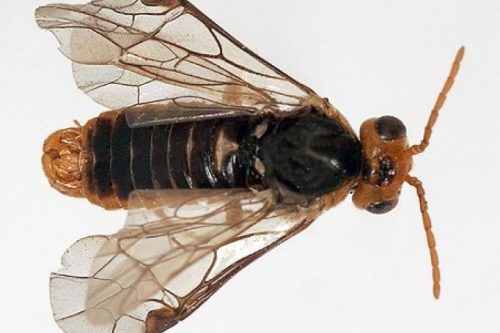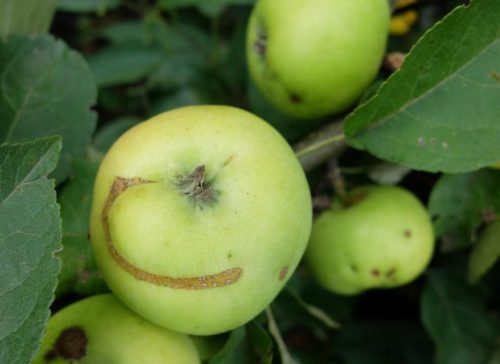The apple sawfly belongs to the sawflies. Sawflies do not have a wasp waist like the ‘regular’ wasps and they do not sting.
Do not confuse with:
Apple leaf sawfly (Pristiphora maesta)
The apple sawfly (Hoplocampa testudinea) belongs to the sawflies (Tenthredinidae). Sawflies do not have a wasp waist like the ‘regular’ wasps and they do not sting.
Sawflies are common in temperate regions (except New Zealand); Europe has about 800 species.
The apple sawfly is about 6 mm long with a wingspan of 5 to 7 mm. The caterpillar-like larvae are between 9 and 11 mm and have a black head when hatching, which turns brown as the larvae (caterpillars) grow.
The caterpillars of the apple sawfly can easily be confused with those of the codling moth. However, apple sawfly larvae have ten pairs of legs instead of eight pairs like true caterpillars. Apple (Malus) is the host plant of this sawfly.
The apple sawfly has only one generation per year. The caterpillars overwinter as a cocoon a few centimeters underground. After pupation in the spring, the fully grown sawflies emerge in April/May, during the flowering of the apple trees. Especially in the morning and the sun high, they can be seen on warm, sunny days. The female lays only one egg (white, 1 mm in size) in the ovary of the flower. After two weeks, a larva (caterpillarlike) – no larger than 2 mm – emerges from the egg and eats itself via a shallow mining passage from the calyx to the outside of the fruit. This hole grows as a corked scar along with the apple and is later visible on the apple as ribbon-like scar. The caterpillar then eats other fruits, producing orange-brown excrement. When the seeds have been eaten, the young apples will fall off in June. When the larva is mature, the caterpillar falls to the ground, disappears into the soil where it makes a cocoon, in which the caterpillar hibernates.
The caterpillars of the apple saw wasp can cause considerable damage. In professional fruit growing, glue traps are used in the spring: as soon as about 30 sawflies occur per trap (one trap per 2500 m2 ), control is necessary. In the private garden, the occurrence of sawflies is not monitored, so it can happen that one day in May an apple tree turns out to be full of caterpillars of the apple sawfly.
Parasitoid wasps and birds are the natural enemies. Biological control is applied by using parasitoid wasps (Lathrolestes ensator). This wasp species lays its eggs in the larvae of the apple saw wasp.
Affected plants
- Apple tree
Remedy
Difficult to to control; as soon as the caterpillars become visible, the damage is already done. Apples are affected. Shake the tree regularly so that affected fruit falls off. Dispose of infected apples to the recycling center. A biological and environmentally friendly pesticide is an extract made from bitter wood (Quassia extract) .
Prevention
Provide a bird-friendly environment: vo
Treating the apple


